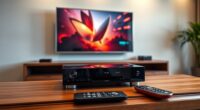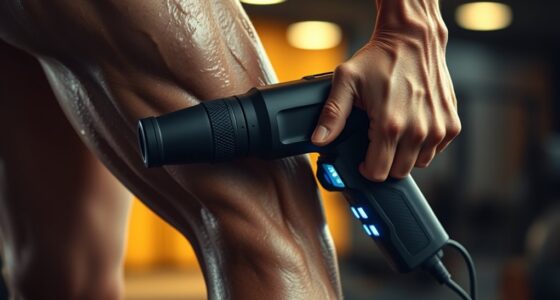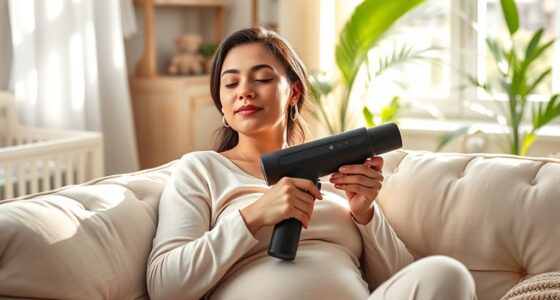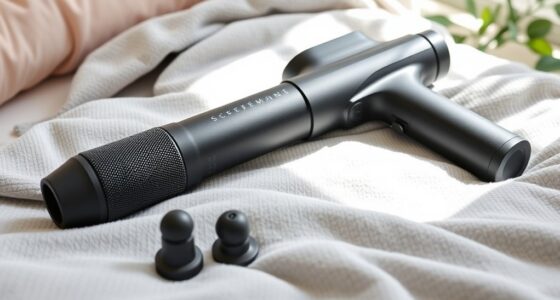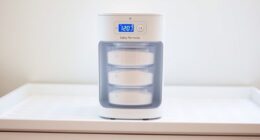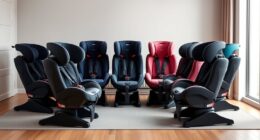If you’re looking for the best whole-house air purifiers for allergies, I recommend units with true HEPA filters, multi-stage filtration, and high airflow coverage. Models like the Levoit Core 400S-P, Winix 5520, and Blueair HEPASilent stand out for their effectiveness in large spaces. They also feature smart controls and washable filters. Keep in mind the size and maintenance needs, and you’ll find these options can truly make a difference. If you keep exploring, you’ll discover even more tips to improve your indoor air quality.
Key Takeaways
- Look for models with multi-stage filtration, including true HEPA and activated carbon filters, for comprehensive allergen and odor removal.
- Ensure the purifier covers large areas (up to 2,200 sq.ft.) with high airflow rates for quick and effective allergen elimination.
- Choose WiFi-enabled units with smart sensors, automation, and remote control for convenient, real-time air quality management.
- Prioritize units with washable pre-filters and easy maintenance features to sustain long-term performance and reduce replacement costs.
- Consider design and size to fit your space, ensuring quiet operation and practical placement for optimal allergen reduction.
Air Purifiers for Large Rooms with Washable Filters
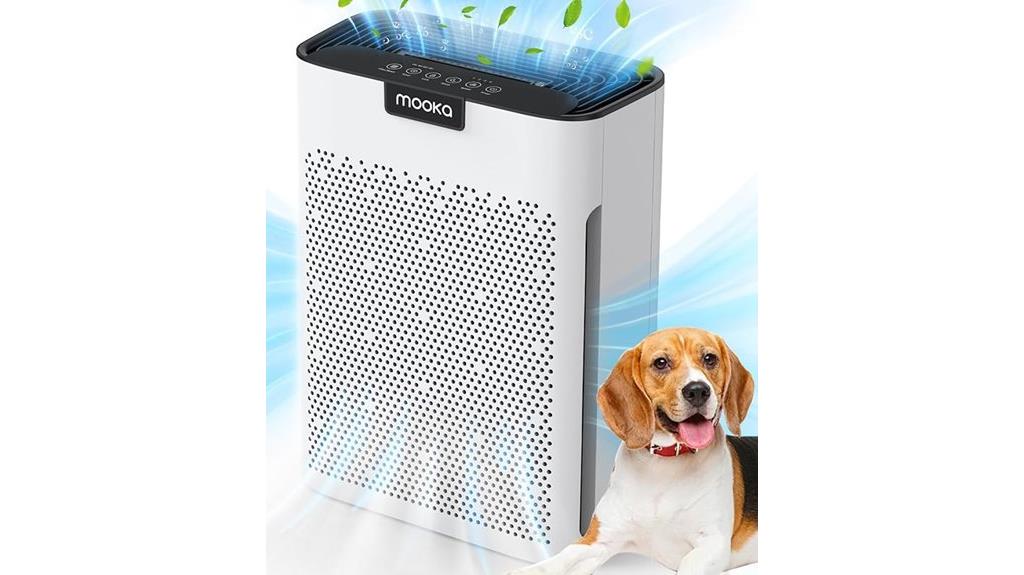
If you have a large room and want an effective, low-maintenance air purifier, these models with washable filters are an excellent choice. They feature larger air inlets on the front and sides, improving airflow and trapping pet hairs and odors better. Capable of covering up to 2200 ft² per hour, they’re perfect for pet owners and big spaces. Their high-efficiency 3-stage filtration captures particles as small as 0.3 microns, including pollen, dust, and dander. The washable pre-filter extends filter life, while activated carbon absorbs odors. With adjustable speeds, timers, and quiet sleep mode, they combine power, convenience, and energy efficiency for a healthier environment.
Best For: pet owners and individuals with large, spacious rooms seeking an effective, low-maintenance air purifier with washable filters.
Pros:
- High coverage area of up to 2200 ft² per hour for large spaces
- 3-stage filtration system efficiently captures small airborne particles and odors
- Washable pre-filter reduces replacement costs and extends filter lifespan
Cons:
- May be more expensive initially due to advanced features and filtration system
- Larger size might require more space for placement and storage
- Noise level at higher speeds might be noticeable despite quiet sleep mode
LEVOIT Air Purifier for Large Rooms (Core 400S-P)

The LEVOIT Air Purifier for Large Rooms (Core 400S-P) stands out as an ideal choice for those who need to purify entire large spaces quickly and efficiently. Certified by ANSI-accredited AHAM, it boasts verified CADR ratings—smoke 231 CFM, dust 240 CFM, pollen 259 CFM—indicating strong performance. Designed for rooms up to 1,733 sq ft, it cleans the air in just an hour. Its 3-in-1 filtration system captures 99.97% of airborne particles, removes gases and odors, and uses smart sensors to adjust fan speed automatically. WiFi-enabled and compatible with voice assistants, it offers easy control and real-time air quality monitoring for healthier indoor air.
Best For: households or large spaces up to 1,733 sq ft seeking efficient, smart air purification with real-time air quality monitoring and odor removal.
Pros:
- Certified by ANSI-accredited AHAM with verified CADR ratings for reliable large-room performance
- 3-in-1 filtration system effectively captures 99.97% of airborne particles and removes gases and odors
- WiFi connectivity and compatibility with Alexa and Google Assistant allow convenient remote and voice control
Cons:
- Relatively large size and weight may be less suitable for smaller or more portable needs
- Higher initial cost compared to basic air purifiers without smart features
- Requires periodic filter replacement recommended for optimal performance
WINIX 5520 Air Purifier for Large Rooms
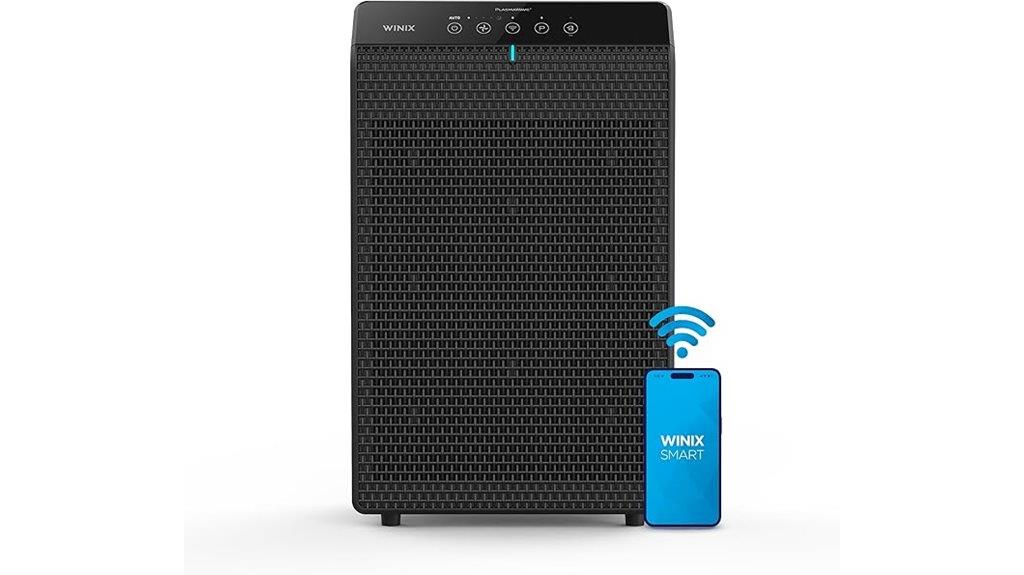
For those living in large spaces and seeking effective allergy relief, the WINIX 5520 Air Purifier stands out with its ability to clean areas up to 1,882 sq ft within just an hour. Its 4-stage purification system, including a True HEPA filter, captures 99.99% of airborne allergens as small as 0.01 microns—pollen, dust, smoke, pet dander. PlasmaWave® technology reduces pollutants, while smart sensors monitor air quality and adjust fan speeds automatically. Quiet and energy-efficient, it features sleep mode for nighttime operation. Certified by AHAM and Energy Star, this purifier combines powerful filtration with smart control, making it ideal for large, allergy-prone households.
Best For: households with large living spaces, allergy sufferers, and pet owners seeking comprehensive air purification and allergen relief.
Pros:
- Capable of cleaning large rooms up to 1,882 sq ft within an hour, ideal for spacious environments.
- 4-stage filtration system with True HEPA and activated carbon filters effectively remove allergens, pollutants, and odors.
- Smart features like real-time air quality sensors, auto mode, and Wi-Fi compatibility for convenient, automated control.
Cons:
- The device may be relatively heavy at 13.3 pounds, making portability slightly less convenient.
- Higher initial cost compared to basic air purifiers, reflecting its advanced features and large coverage.
- Noise level can be as low as 27 decibels, but some users may find fan operation noticeable during certain modes.
EVALIT Air Purifier for Large Rooms (1 Pack, White)

Designed to cover up to 2,200 square feet, the EVALIT Air Purifier for Large Rooms is an excellent choice for anyone with expansive living spaces or open-plan offices seeking effective allergy relief. Its three-stage filtration captures particles as small as 0.3 microns, including pollen, dust, smoke, and odors. The washable pre-filter reduces costs and waste, while a special pet mode handles pet hair and dander. It features a PM2.5 sensor for real-time air quality updates, auto mode for efficiency, and a dedicated essential oil compartment for aromatherapy. User-friendly with adjustable speeds, a timer, and child lock, it combines powerful purification with a calming atmosphere.
Best For: those with large living or working spaces seeking effective air purification, allergy relief, and a calming environment.
Pros:
- Covers up to 2,200 sq.ft., ideal for large rooms and open areas
- Three-stage filtration effectively captures particles as small as 0.3 microns, including allergens and odors
- Features a PM2.5 sensor with auto mode for efficient, real-time air quality management
Cons:
- May be larger and bulkier, requiring more space for placement
- The cost of replacement filters could add up despite washable pre-filter benefits
- Some users might find the multiple functions and settings slightly complex to navigate initially
BLUEAIR Air Purifiers for Large Rooms, HEPASilent Smart Air Cleaner

If you need an efficient solution for large spaces affected by allergies, the BLUEAIR Blue Pure 211i Max stands out with its advanced HEPASilent dual filtration technology. It covers up to 3,048 sqft and cleans 1,524 sqft in 30 minutes, removing 99.97% of airborne particles down to 0.1 microns, including viruses, pollen, dust, and smoke. Its smart features—app control, sensors, real-time air quality monitoring, and customizable settings—make it easy to use. Quiet and energy-efficient, it’s certified for safety and performance, making it an excellent choice for large rooms with allergy sufferers or pets.
Best For: households and large spaces needing efficient air purification for allergies, pets, viruses, and smoke with smart control features.
Pros:
- Highly effective filtration with a CADR of 410 and ability to remove 99.97% of airborne particles down to 0.1 microns
- Smart features including app control, air quality sensors, and customizable settings for ease of use
- Quiet operation certified by Quiet Mark and energy-efficient with low power consumption
Cons:
- Larger footprint may require more space and placement considerations
- Optional pre-filters sold separately, adding to ongoing maintenance costs
- The device’s advanced features may have a learning curve for some users unfamiliar with smart home integrations
Factors to Consider When Choosing Whole-House Air Purifiers for Allergies
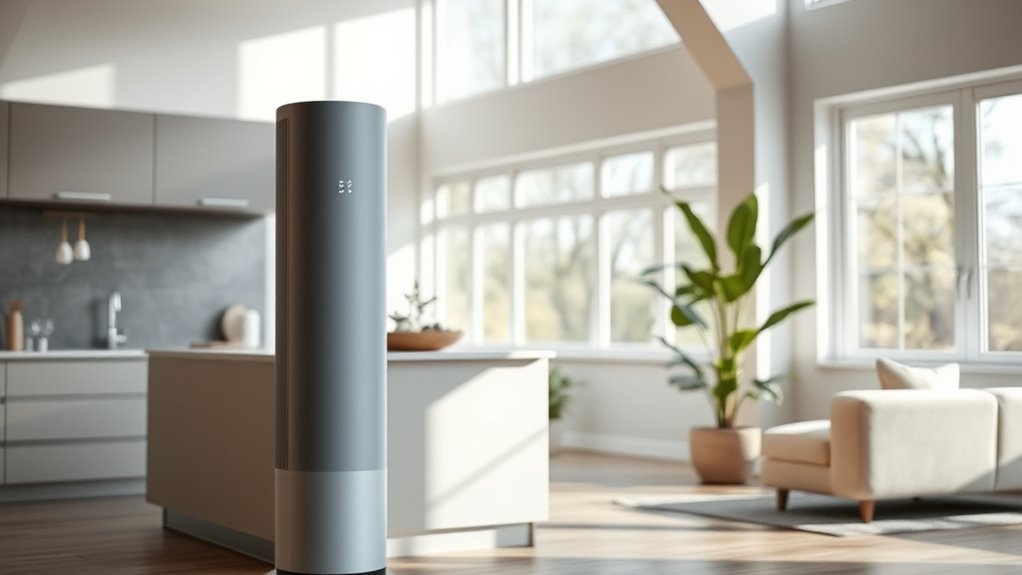
When choosing a whole-house air purifier, I focus on several key factors to guarantee it meets my needs. I consider the airflow capacity, filter effectiveness, and how easy it is to maintain and replace filters. Additionally, I look at energy use and whether smart controls are available to make operation more convenient.
Airflow Capacity Needs
Choosing the right airflow capacity is crucial for guaranteeing your whole-house air purifier effectively clears allergens from your home. An airflow of at least 400 CFM is recommended to filter the entire home within 30 minutes, providing fast and thorough purification. Larger homes or those with high ceilings may require 600 CFM or more to ensure complete coverage. It’s important that the unit’s airflow matches your home’s square footage; for example, a system rated for 2,000 sq ft should adequately serve that space. Higher airflow capacity not only speeds up allergen removal but also improves overall air circulation, preventing stagnant pockets where allergens can settle. Proper airflow ensures consistent performance, making your air purifier more effective at reducing pollen, dust, pet dander, and other airborne irritants.
Filter Effectiveness Levels
The effectiveness of a whole-house air purifier largely depends on its filtration levels, which determine how well it can remove microscopic allergens from your indoor air. Higher MERV ratings, especially between 13 and 20, indicate more efficient removal of allergens like pollen, dust mites, and pet dander. True HEPA filters are particularly effective, capturing at least 99.97% of airborne particles as small as 0.3 microns, providing significant allergy relief. Adding activated carbon filters helps eliminate odors and VOCs that can worsen allergy symptoms. Systems with multiple filtration stages outperform single-filter setups, offering thorough allergen removal. However, to maintain their effectiveness, filters need regular replacement or cleaning, ensuring continued peak performance over time.
Maintenance & Replacement
Regular maintenance is essential to guarantee your whole-house air purifier continues to effectively remove allergens. I recommend checking filters regularly and replacing them as the manufacturer suggests, usually every 6 to 12 months. Washable filters should be rinsed or vacuumed periodically to remove dust and debris, which extends their lifespan. It’s important to keep track of filter change alerts or reminders to avoid performance drops. Using high-efficiency filters compatible with your system ensures small particles, like allergens and pollutants, are captured effectively. Proper maintenance not only maintains ideal air quality but also prevents mold or bacterial growth inside the unit. Staying consistent with filter replacements and cleaning keeps your system running smoothly and ensures it continues to protect your home from airborne allergens.
Energy Consumption Rates
Considering energy consumption rates is crucial when selecting a whole-house air purifier for allergies, as these units can vary widely in power usage. Most models use between 30 to 100 watts, depending on fan speed and features. Opting for energy-efficient units with Auto or Eco modes helps reduce power consumption by lowering fan speed when air quality is good. Running a purifier at high speeds continuously can lead to higher electricity bills over time. Some models are Energy Star certified, which guarantees they meet strict efficiency standards. Monitoring and adjusting settings based on real-time air quality can further optimize energy use and minimize waste. Balancing effective air purification with reasonable energy consumption ensures you get the most value from your investment.
Smart Control Features
Smart control features substantially enhance the convenience and functionality of whole-house air purifiers for allergies. With remote operation via smartphone apps, I can monitor and adjust my system effortlessly, even when I’m away. Real-time air quality data allows the purifier to automatically increase or decrease fan speed, ensuring ideal purification without manual intervention. Voice control compatibility with Alexa or Google Assistant offers hands-free convenience, seamlessly integrating the purifier into my smart home setup. Scheduling options and timers let me customize operation times, reducing energy waste and maintaining clean air precisely when needed. Advanced features like filter tracking, maintenance alerts, and auto mode keep the system performing at its best, simplifying upkeep and ensuring consistent allergy relief.
Room Size Compatibility
Choosing the right whole-house air purifier starts with guaranteeing it can handle your space. First, check that the unit is rated for your home’s square footage or specific area. This ensures it can effectively filter the air throughout your home. Pay attention to the Clean Air Delivery Rate (CADR), which indicates how quickly the purifier can clean large spaces. For thorough coverage, select a unit designed to cover at least the size of your largest room or open area. If you want purification across multiple rooms, consider multi-room or ducted systems that distribute clean air evenly. Most importantly, verify that the purifier’s capacity matches your home’s total square footage, so you get ideal air quality improvements without overloading the system.
Certification & Safety
Ensuring your whole-house air purifier is safe and effective starts with checking its certifications. Reputable organizations like AHAM, Energy Star, CARB, and ETL verify that the purifier meets rigorous safety and performance standards. CARB certification guarantees the device produces less than 5 parts per billion of ozone, making it safe for indoor air, especially for allergy sufferers. AHAM verification confirms independent testing of filtration efficiency, airflow, and energy use, ensuring reliability. Energy Star certification indicates energy efficiency, helping reduce operational costs and environmental impact. Additionally, you should verify that the purifier doesn’t emit harmful substances like excessive ozone or UV light, which could pose health risks. Prioritizing certified products guarantees you choose a safe, effective, and dependable air purifier for your home.
Frequently Asked Questions
How Often Should Washable Filters Be Cleaned for Optimal Performance?
I recommend cleaning washable filters at least once a month for peak performance. If you notice more dust or allergies acting up, you might want to clean them every two weeks. Regular cleaning keeps airflow clear and prevents buildup that can strain the system. I always keep track of cleaning schedules to guarantee my air purifier works efficiently, especially during allergy seasons when air quality matters most.
Do These Air Purifiers Effectively Remove Pet Dander and Pollen?
Oh, absolutely, these purifiers are the superheroes of allergy relief! They trap pet dander and pollen with ease, making your home feel like an allergy-free sanctuary. I’ve seen them work wonders, actually reducing sneezing fits and itchy eyes. So yes, if you want to breathe easier and say goodbye to allergy misery, these devices genuinely deliver by capturing those pesky allergens right at the source.
Are Replacement Filters Required Regularly for These Models?
Yes, replacement filters are needed regularly for these models to keep them running effectively. I recommend checking the manufacturer’s guidelines, which often suggest replacing filters every 6 to 12 months, depending on usage and air quality. I stay on top of filter changes because clean filters guarantee ideal performance, especially for allergy relief. Regular replacements help maintain fresh indoor air and prevent allergens from building up.
Can These Purifiers Operate Quietly During Nighttime?
Yes, many of these air purifiers operate quietly at night, allowing me to sleep peacefully without noise disruptions. I look for models with a sleep mode or low-speed setting, which considerably reduces noise levels. In my experience, these features make a big difference, so I can enjoy cleaner air without sacrificing restful sleep. Always check product specifications for noise ratings to guarantee they meet your quietness needs.
What Is the Typical Lifespan of the HEPA Filters in These Units?
Think of HEPA filters as the heart of your purifier, beating steadily to keep your air clean. Typically, these filters last about 6 to 12 months, depending on usage and air quality. I suggest checking your unit’s manual or indicator light regularly—it’s like a health checkup for your purifier. Replacing filters on time guarantees your home stays a sanctuary, free of allergy triggers, with fresh, breathable air every day.
Conclusion
Choosing the right whole-house air purifier is like finding a lighthouse in a foggy night—guiding you safely through allergy season. With options from LEVOIT, WINIX, EVALIT, and BLUEAIR, you can breathe easier knowing you’re tackling allergens at their source. Remember, the best purifier is the one that fits your space and needs. Don’t let allergens cast shadows over your home—shine a light on clean, fresh air today.

